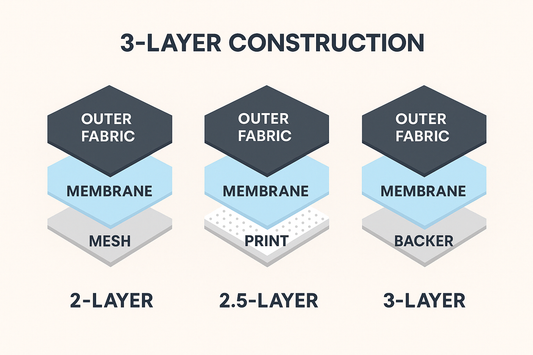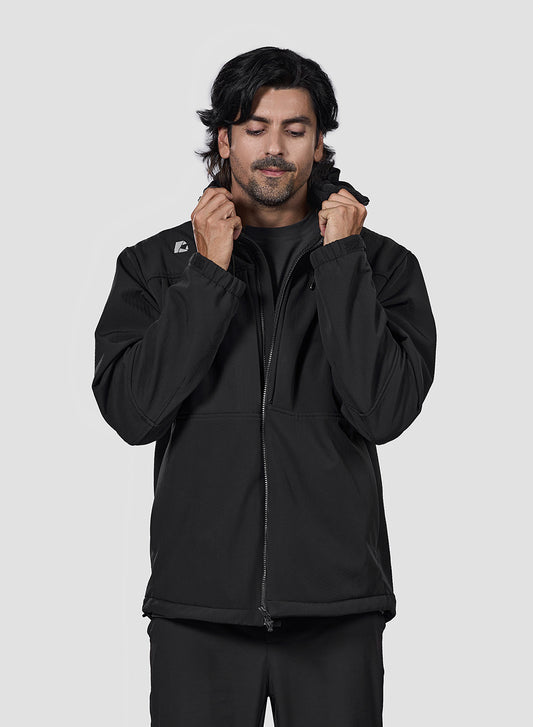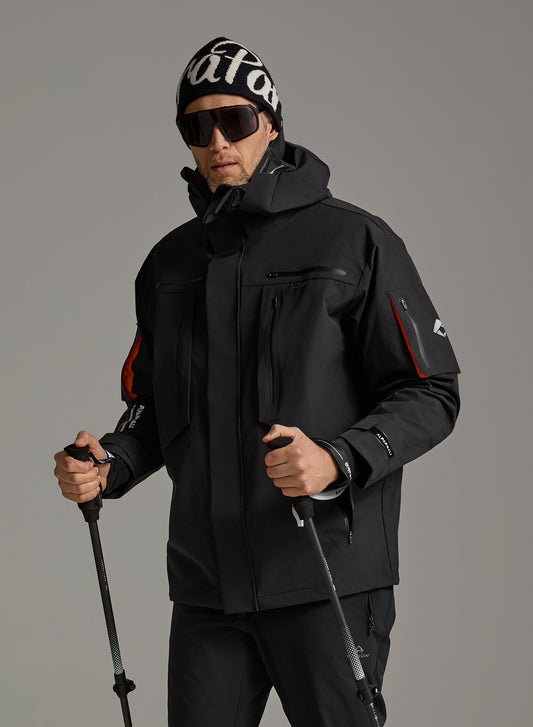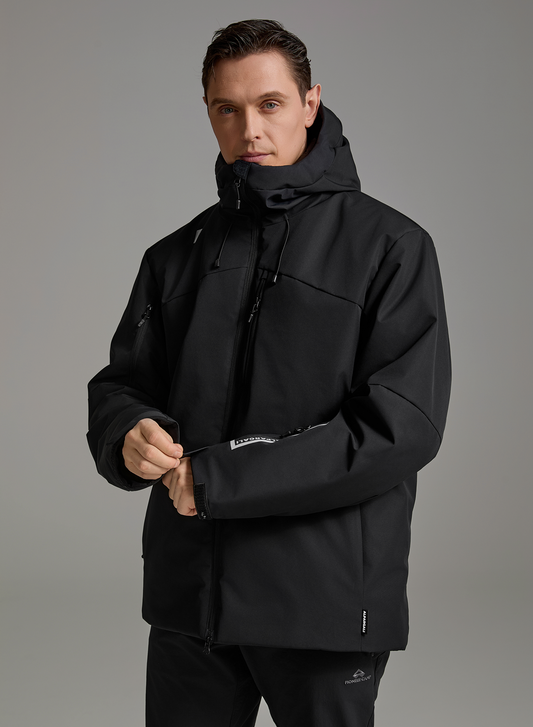
Why Cotton Might Be the Wrong Choice for Your Hike and What to Wear Instead
Share
You’ve probably heard the phrase "cotton kills" thrown around in hiking circles, and while it may sound dramatic, there’s some truth behind it. Cotton, while comfortable and breathable, isn’t the best choice for outdoor adventures. In certain conditions, it can lead to discomfort and even safety risks.
That doesn’t mean cotton is always the enemy, but understanding when it’s a good idea to leave it at home is key. In this post, we’ll explain why cotton isn’t ideal for hiking, especially in tough weather, and recommend the fabrics that truly keep you comfortable, dry, and safe on the trail. With the right gear, your hike can be much more enjoyable—and a lot less risky.
Why Is Cotton Bad for Hiking?
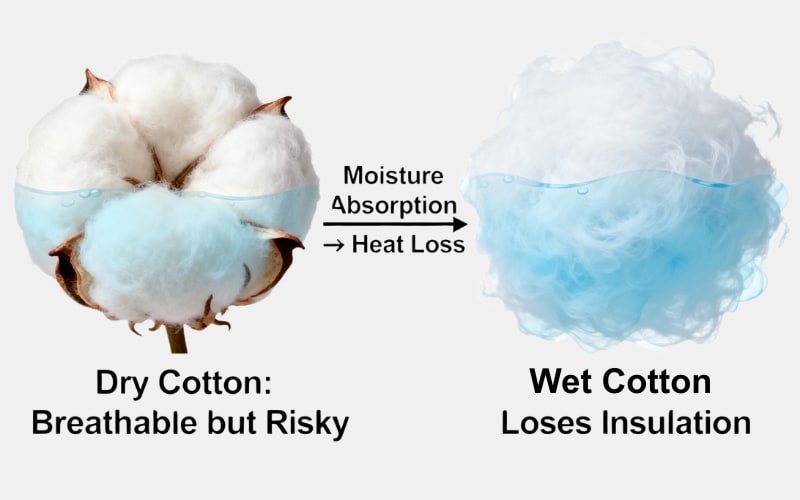
Poor Moisture Absorption and Heat Loss
Cotton absorbs moisture and holds it close to your skin, which sounds fine until you’re hiking in wet conditions. Whether from sweat, rain, or river crossings, wet cotton loses its insulating properties, pulling heat away from the body. In cold or damp environments, this increases the risk of hypothermia—cotton just doesn’t cut it when things get wet.
Slow Drying Time and Added Weight
Cotton takes forever to dry. On the trail, this means soggy, heavy clothes that add unnecessary weight and discomfort. In cold weather, wet cotton also makes you feel colder for much longer, draining your energy and dampening your enjoyment.
Friction Leading to Chafing and Blisters
Wet cotton increases friction on your skin, leading to chafing and blisters—especially in areas like your thighs, underarms, and feet. The discomfort of irritated skin can turn a pleasant hike into a painful one.
Lack of Moisture-Wicking Properties
Unlike synthetic fabrics, cotton doesn’t wick sweat away from your skin. This means moisture stays trapped, leading to clamminess and skin irritation. It can also make you feel cold and uncomfortable, as cotton doesn’t help regulate your body’s temperature as effectively as other materials.
Why Are Cotton Socks Bad for Hiking?
Cotton socks are bad for hiking because they absorb moisture and hold it close to your skin. When your feet sweat or get wet from rain, cotton socks stay damp, causing discomfort, blisters, and increasing the risk of foot problems. Additionally, they take a long time to dry, leaving your feet cold and prone to chafing.
Is Cotton Really Deadly?
Not necessarily. In consistent dry heat, cotton clothing can actually perform well.
Is Cotton Beneficial for Summer Hiking?
In hot, dry weather, like deserts, cotton’s cooling properties can be a great choice for staying comfortable. Its breathability and moisture absorption help keep the body cool by promoting evaporation. In these conditions, cotton is more comfortable than synthetics, which tend to trap heat and moisture against the skin.
Why Is Cotton Bad in Cold Weather?
However, cotton becomes a problem when it gets wet, especially in cold weather. When cotton absorbs moisture, it loses its insulating properties and begins to draw heat away from your body. This leads to rapid heat loss and increases the risk of hypothermia. Additionally, cotton takes a long time to dry, leaving you stuck in wet, cold clothes.
Besides Cotton, What Fabrics Should You Avoid When Hiking?

Besides cotton, there are a few other fabrics you should avoid when hiking:
-
Denim: While durable, denim is heavy, takes forever to dry, and absorbs moisture, making it uncomfortable and dangerous in wet conditions. It also restricts movement, which can be a problem on the trail.
-
Rayon/Viscose: These fabrics may feel soft and lightweight, but they’re prone to absorbing moisture and take a long time to dry. They also offer little insulation, making them a poor choice for unpredictable weather.
-
Acrylic: Acrylic fabric may look like wool but doesn’t provide the same warmth or moisture-wicking properties. It can also feel uncomfortable when wet, and like cotton, it doesn't dry quickly, making it a poor choice for hiking.
-
Silk: While lightweight and breathable, silk doesn’t handle moisture well. It can absorb sweat or rain and takes a long time to dry, leaving you cold and damp on the trail.
When hiking, it’s best to stick to moisture-wicking, breathable fabrics like merino wool, polyester, or nylon, which handle sweat and the elements far better. These materials will keep you dry, comfortable, and safer on the trail.
How Do Cotton Blends Perform for Hiking?
Cotton blends, made of a mix of cotton and synthetic fibers like polyester, offer a balance of comfort and performance, but they have their pros and cons for hiking.
Moisture Management: Cotton blends manage moisture better than pure cotton but still aren’t as effective as merino wool or 100% synthetics. They can wick away sweat more efficiently than cotton alone, but in really wet conditions, they may still leave you damp and uncomfortable.
Durability and Comfort: Blended fabrics tend to be more durable than 100% cotton, offering better resistance to wear and tear. They also provide the softness of cotton, combined with the flexibility and stretch of synthetics, making them comfortable for most hikes.
Drying Time: Cotton blends dry faster than pure cotton, but they still take longer than fully synthetic fabrics. This slower drying time can add weight and discomfort during longer hikes or in wet conditions.
Breathability and Temperature Control: While cotton blends breathe better than 100% cotton, they don’t offer the same temperature regulation as merino wool or high-performance synthetics. They can feel warm and comfortable when dry, but won’t maintain warmth effectively when wet.
In summary, cotton blends can work in dry conditions where comfort is key, but for wet or cold weather, it’s better to choose fully synthetic fabrics or merino wool for superior moisture-wicking, faster drying, and better temperature control.
Alternatives to Cotton: Which Fabrics Are Better for Hiking?
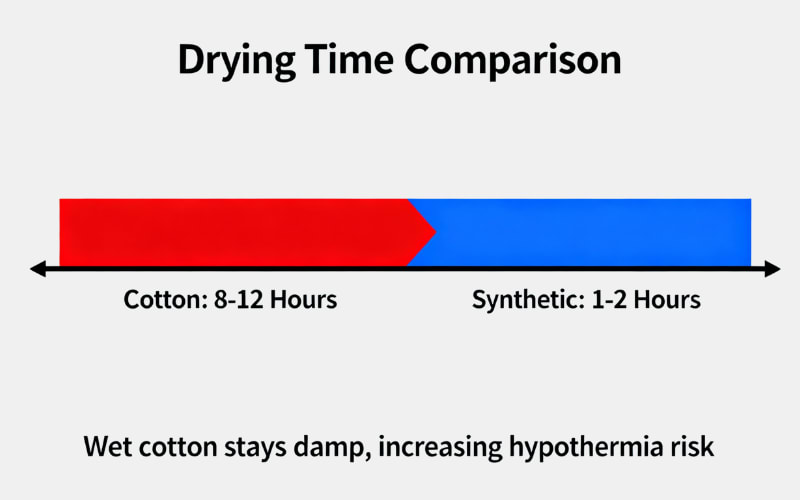
Wool: The Natural Choice for Wet Conditions
Merino wool is an excellent alternative to cotton, especially in wet or cold conditions.
-
Warmth Even When Wet: Unlike cotton, wool retains its insulating properties even when wet, making it ideal for damp environments.
-
Antimicrobial Properties: Merino wool resists odor, which is perfect for longer hikes.
-
Moisture-Wicking: Wool pulls moisture away from the skin and allows it to evaporate, keeping you dry and comfortable.
Merino wool is a natural fabric that excels in variable weather, ensuring warmth and comfort without the risk of cotton’s drawbacks.
Synthetic Fabrics: Quick-Drying, Lightweight, and Durable
Synthetic fabrics like polyester, nylon, and polypropylene are commonly used for outdoor gear, each offering unique advantages.
-
Polyester:
-
Moisture-Wicking: Pulls sweat away from the skin, drying quickly.
-
Lightweight & Durable: Polyester is ideal for base layers and activewear, keeping you comfortable during high-exertion activities.
-
Nylon:
-
Durability: Nylon is tough and abrasion-resistant, making it great for pants and jackets.
-
Water-Resistant: It offers some protection against the elements while still being breathable.
-
Polypropylene:
-
Best for Base Layers: One of the best fabrics for moisture-wicking, it keeps you dry during intense activity.
-
Quick-Drying: Doesn’t absorb moisture, ensuring it stays light and dry during heavy sweating.
Overall Performance:
Synthetic fabrics dry quickly, manage moisture well, and are lighter than cotton when wet. They offer significant advantages for hiking in all weather conditions, especially when compared to cotton's slow drying and discomfort in wet conditions.
Technical Graphene Fabrics: Efficient Heat Retention and Quick Moisture Wicking
- Lightweight: Graphene is extremely light, making hiking gear like shoes, backpacks, and clothing easier to carry, reducing physical strain during long hikes.
- Durability and Tear Resistance: Graphene’s strength surpasses steel, enhancing the durability and tear resistance of hiking gear, even in harsh conditions.
- Breathability and Comfort: Graphene regulates temperature and moisture, improving breathability in clothing to keep hikers dry and comfortable during long walks.
- Antibacterial and Odor Resistance: Graphene’s antibacterial properties help prevent bacterial growth, keeping gear clean and reducing odor caused by sweat and moisture.
Graphene fabrics represent a cutting-edge alternative to cotton, combining moisture-wicking, heat retention, and breathability in a single material, making them a great option for high-performance hiking gear.
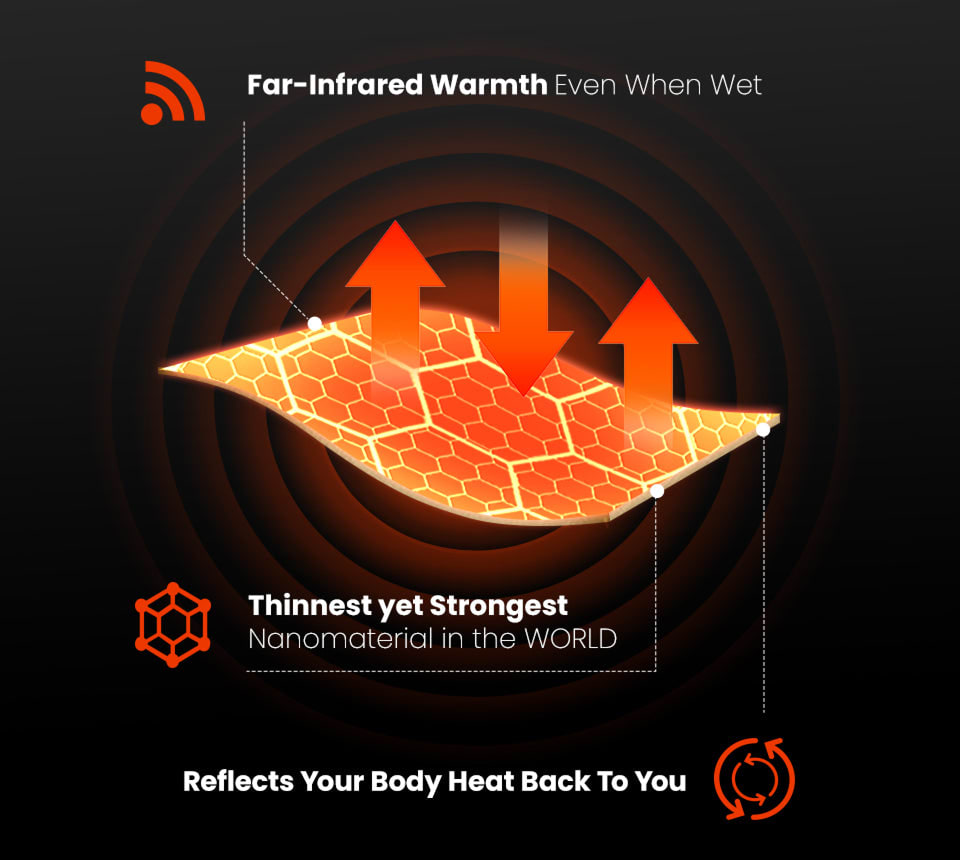
How to Choose the Right Hiking Apparel?
When selecting appropriate hiking clothing, it’s important to consider the environment, weather, activity intensity, and personal comfort needs. Here are key points to keep in mind when choosing hiking apparel:
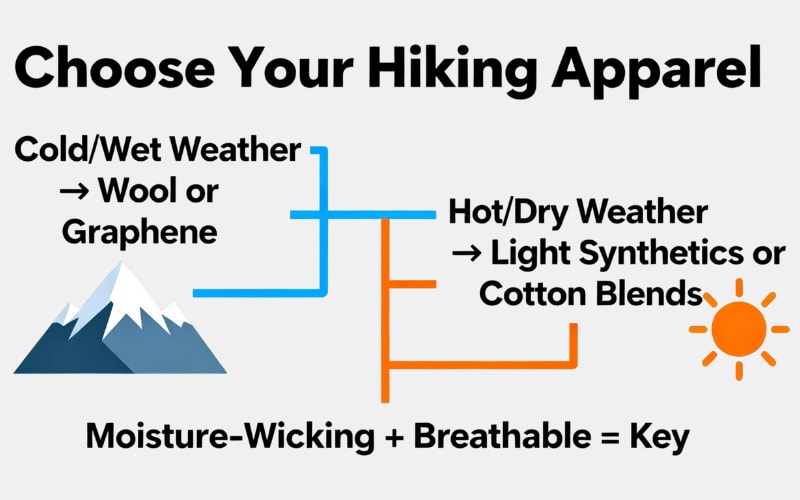
Fabric Choice:
- Opt for synthetic fibers (like polyester or nylon), wool, or graphene, as they offer excellent moisture-wicking, odor-resistance, and breathability. Wool is ideal for cold weather, while synthetic fibers and graphene perform well in varying climates.
- Breathability is crucial, especially during high-intensity hikes. Ensure the clothing chosen is breathable to prevent overheating and excessive sweating.
Comfort and Fit:
- Ensure the clothing fits well but isn’t too tight. Tight clothing can restrict circulation, while loose clothing may cause friction and discomfort. Look for clothes that allow freedom of movement, especially in pants and jackets.
Weather Adaptability:
- In cold weather, choose jackets with adjustable hoods and warm, breathable base layers.
- In hot weather, choose light, breathable clothing with UPF sun protection.
- In damp or rainy conditions, make sure your outer layer is waterproof to prevent moisture from soaking in.
Functionality:
- Choose clothing with multiple pockets to carry essentials like maps, food, and phones.
- For long hikes, look for adjustable waistbands and cuffs to customize the fit for comfort.
Accessories:
-
Socks: Opt for breathable, moisture-wicking, and antibacterial socks, such as wool or technical synthetic fabrics, to avoid blisters.
- Hats and Gloves: For cold weather, choose warm, windproof hats and gloves. In sunny conditions, wear hats with UV protection.
Hiking Apparel Recommendations
Graphene Lightweight Jacket

The Graphene Lightweight Jacket is the ultimate solution to staying warm without the bulk or discomfort of traditional winter wear. With cutting-edge graphene technology, this jacket locks in heat and wicks away moisture in a way that no other fabric can, giving you an unmatched outdoor experience.
What You’ll Love:
-
Stay Warm, No Matter the Conditions: Thanks to graphene's superior heat conductivity, it reflects your body’s heat back, creating a constant warmth that keeps you comfortable, even in chilly, damp conditions. You won’t feel cold, and you won’t feel overheated—it’s the best of both worlds.
-
Dry and Fresh for Longer: Its unique porous structure quickly absorbs sweat and moisture, releasing it to keep you dry, preventing the chill and discomfort you often get with other jackets that trap moisture.
-
Antibacterial for Long Adventures: Sweaty, damp gear can lead to unpleasant odors and bacteria buildup. This jacket's antibacterial features keep you feeling fresh for longer, especially useful on longer hikes or frequent outdoor activities.
If you’re tired of layering up with bulky winter gear that leaves you sweaty and cold, the Graphene Lightweight Jacket is your next must-have. It’s the future of outdoor clothing, and once you try it, you’ll wonder how you ever hiked without it.
Men’s All-Weather Outdoor Jacket
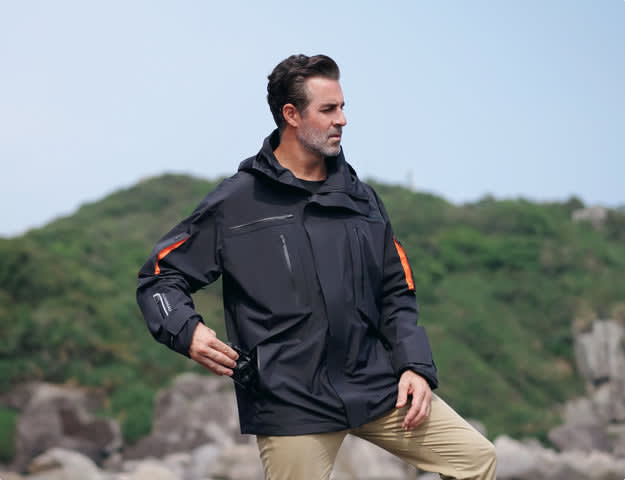
Whether it’s unexpected rain, wind, or freezing temperatures, the Men’s All-Weather Outdoor Jacket is built to handle it all. This jacket isn’t just about looking good; it’s about performance, comfort, and protection when you need it most.
Why This Jacket Will Become Your Go-To:
-
Windproof and Warm: The high collar and adjustable hood seal in warmth and keep cold winds at bay. No more freezing wind cutting through your jacket on windy hikes or outdoor activities.
-
Cool and Comfortable: Underarm ventilation keeps you cool even when you’re pushing hard on tough trails. Plus, the slanted front zipper adds a modern, functional twist to your jacket, making it as comfortable as it is stylish.
-
Built for Adventure: With 13 waterproof YKK zippers and a flexible shoulder system, this jacket won’t hold you back. Whether you're hiking, climbing, or just exploring, you'll have all the freedom of movement you need while staying dry and protected.
If you want a jacket that adapts to any weather conditions while offering maximum comfort and durability, this All-Weather Outdoor Jacket is the one. It’s a no-brainer for anyone who loves the outdoors but doesn’t want to sacrifice style or functionality.
Gear Up for Your Next Adventure with Alpargali
The right hiking gear can make all the difference between an enjoyable adventure and a challenging one. From staying warm in cold weather to keeping dry and comfortable in the heat, your apparel is essential to your outdoor experience. At Alpargali, we focus on providing high-performance gear designed to keep you comfortable, protected, and ready for whatever the trail throws at you.
Our Jackets are perfect examples of our commitment to quality and innovation. Built with cutting-edge technical fabrics and thoughtful design, these jackets offer warmth, moisture-wicking, and breathability, ensuring you're prepared for any conditions.
Ready to level up your hiking gear? Explore our Hiking Guide for expert tips, gear recommendations, and more to help you prepare for your next adventure.

